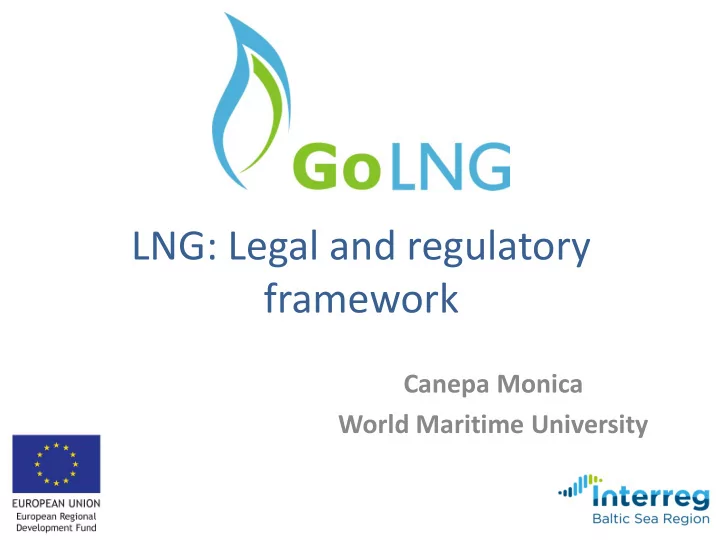

LNG: Legal and regulatory framework Canepa Monica World Maritime University
AIR QUALITY INDEX 2017 Source: Verisk Maplecroft
Policies and legal instruments for clean energy to support LNG GLOBAL REGIONAL NATIONAL
Policies and legal instruments for clean energy to support LNG GLOBAL Increasing recognition of environmental benefits • G20 endorses the role of natural gas in energy transition • IEA credits levelling of global CO2 emissions to coal displacement
Policies and legal instruments for clean energy to support LNG REGIONAL EU policies supporting coal phase out • More than 10 countries announce coal phase-out ambitions -25% of coal power capacity in EU • EU confirms reforms to strengthen EU Emissions Trading Scheme
Policies and legal instruments for clean energy to support LNG NATIONAL Germany • Ship safety law (Schiffsicherheitsgesetz) (SchSG): Interim guidelines on safety for natural gas fuelled engine installations in ships (MSC.285(86)) Norway • Greenhouse Gas Emission Trading Act issued by the Norwegian Environment Agency
Policy and legal intruments- Global IMO Regulations MARPOL 73/78 is an environmental convention to prevent marine water quality pollution and marine air pollution that may occur because of ships. The convention has been continuously revised since its adoption in 1978. Annex VI of the IMO MARPOL Convention represents the regulatory framework tackling exhaust gas emissions from ships Energy Efficiency Design Index (EEDI), a technical measure of GHG emissions reduction Energy Efficiency Operational Indicator (EEOI) and the Ship Energy Efficiency Management Plan (SEEMP), which together are GHG mitigation measures from an operational perspective
Marpol Annex VI Covered by Annex VI Oxides of Nitrogen (NOx) – create Ozone Sulphur Oxides (SOx) – create acidification Hydrocarbons (HC) – gas, soot and some particulates Volatile Organic Compounds (VOC) Refrigerant Gases Not covered by Annex VI Carbon Dioxide (CO2) Carbon Monoxide (CO)
Policy and legal intruments - Regional ENERGY STRATEGY 2020 By 2020, the EU aims to reduce its greenhouse gas emissions by at least 20%, increase the share of renewable energy to at least 20% of consumption, and achieve energy savings of 20% or more EU WHITE PAPER FOR TRANSPORT The European Commission’s EU White Paper for Transport (2011) has set a greenhouse gas reduction goal of at least 40% by 2050 (compared to 2005) in absolute terms for the shipping sector. EU DIRECTIVE ON ALTERNATIVE FUELS
Policy and legal intruments Emission Control Areas (ECA) established to limit the emission of SOx and particulate matter and those applicable outside such areas and are primarily achieved by limiting the maximum sulphur content of the fuel oils as loaded, bunkered, and subsequently used onboard. The ECAs established are: Baltic Sea area – as defined in Annex I of MARPOL (SOx only); North Sea area – as defined in Annex V of MARPOL (SOx only); North American area (entered into effect 1 August 2012) – as defined in Appendix VII of Annex VI of MARPOL (SOx, NOx and PM); and United States Caribbean Sea area (entered into effect 1 January 2014) – as defined in Appendix VII of Annex VI of MARPOL (SOx, NOx and PM).
Policy and legal intruments Emission Control Areas (ECA) New IMO designated Emission Control Areas expected to be declared in the Mediterranean, Australia and Asia.
EMISSIONS CONTROL AREAS (ECA ´ s)
Timeline towards 2030 Source: DNV GL , ( 2016)
IMO REGULATIONS LNG The most relevant IMO regulations applicable to the use of LNG as a fuel for shipping, based on a feasibility study carried out by the IMO on 2016, are listed as below: • SOLAS convention including requirements for maritime fuels • STCW convention including training requirements for crews • International Code for Construction and Equipment of Ships Carrying Liquefied Gases in Bulk (IGC Code, referenced within SOLAS Chapter VII, Part C) including requirements for the construction and operation of LNG tanker • Interim Guidelines on Safety for Natural Gas-Fuelled Engine Installations in Ships MSC.285(86) • International Code of Safety for Ships using Gases or other low Flashpoint Fuels (IGF Code, including requirements for the construction and operation of gas-fuelled ships)
IMO REGULATIONS LNG LNG is classified as dangerous goods according to the SOLAS Convention on Maritime Dangerous Goods Code (class 2 and class 3). Safety issues must be regulated by States Authorities on the basis mentioned in the Convention.
Code for ships using gases or other low-flashpoint fuels (IGF Code) • IGF Code aims to minimize the risk to ships, their crews and the environment, given the nature of the fuels involved, IMO said in its statement. • IGF Code will take effect on 1 January, 2017, providing a clear legislative framework for ships to install LNG fuel systems • Amendments to the International Convention for the Safety of Life at Sea (SOLAS) require new ships using gases or other low-flashpoint fuels to comply with the requirements of the IGF code
Code for ships using gases or other low-flashpoint fuels (IGF Code) • Before 2017 ships had LNG or other low flashpoint fuel systems need to obtain permits from each port authority or the maritime administration in the countries where they call, but from 2017, vessels built and approved in accordance with the IGF Code are able to trade freely around the world.
Recommend
More recommend